Types of trellises for raspberries
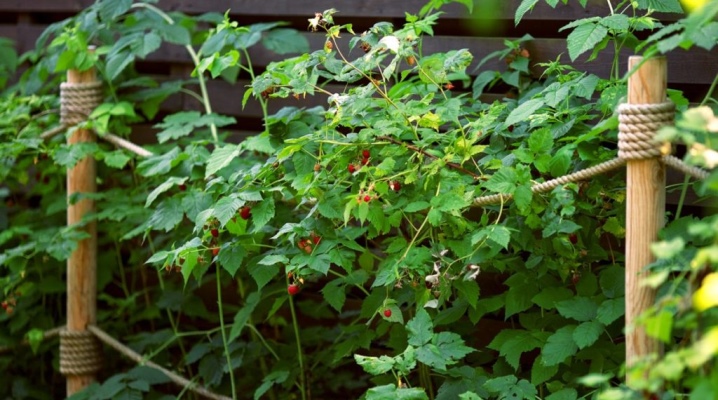
Raspberries ripen quickly, have an unsurpassed taste and aroma. Many people grow the berry, because it is also very useful. Fast and simple propagation of the bush, ease of maintenance make it universal - even a gardener without experience will keep track of it. After the spring planting, harvesting can be done in the second year. Trellis make it easy to grow and care for raspberries.
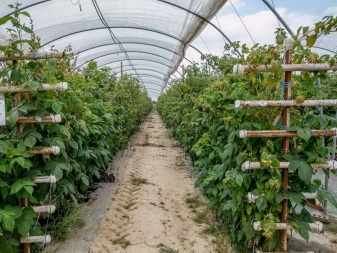
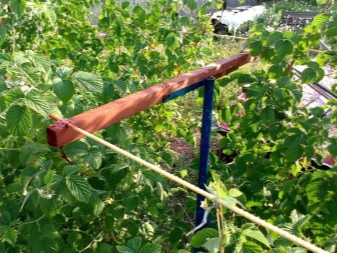
What is it and what is it for?
Trellis for raspberries are a kind of supports for the bush. The design prevents damage to the branches that tend to the ground under the load of berries. Many raspberry varieties grow up to 2 meters, but have thin branches. In this case, trellises are simply necessary for cultivation. If raspberry berries lie on the ground, then various insects will very quickly come running on them.
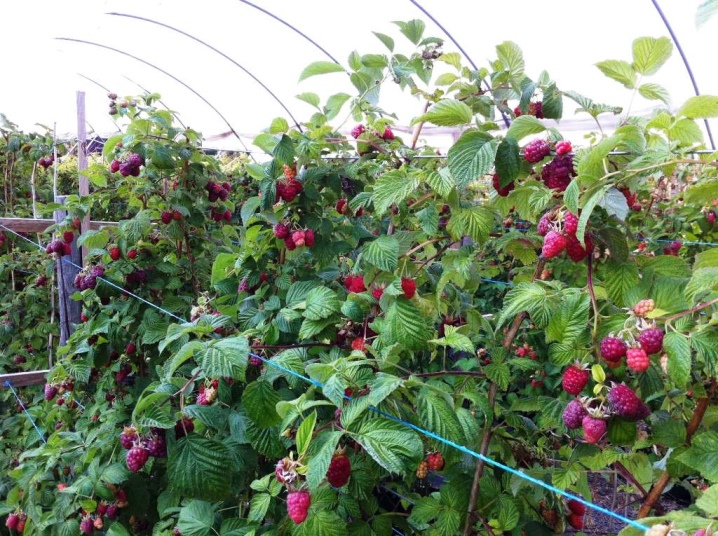
It is possible not to use the structure when growing undersized varieties. If you plan to grow raspberries of early ripening and high productivity, then you will not be able to do without a trellis. It is important to plant the bushes in even rows. With a chaotic seating, you will have to equip additional supports.
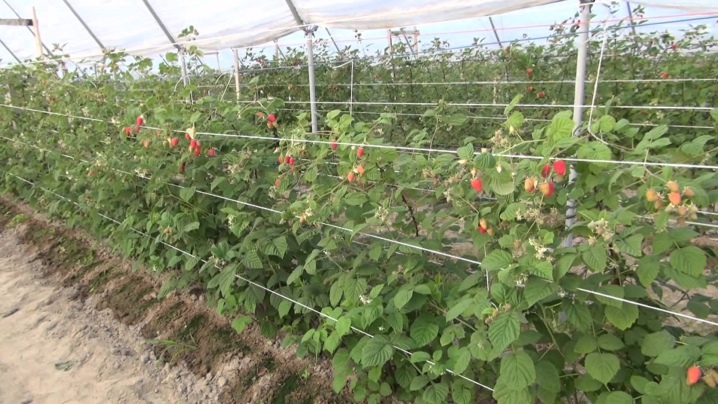
Raspberry trellis have a number of advantages.
-
With their help, you can form beautiful and neat rows.
-
The lower branches do not come into contact with the ground, so they do not get dirty. As a result of using the construction, the plant is not attacked by snails, frogs and other pests.
-
The berries are clean even on rainy days.
-
Trellis allow you to form regular rows with large gaps between the bushes. Thanks to this, the plant is well blown by the wind and dries up. As a result, the risk of fungal diseases disappears.
-
When planted evenly, all branches receive sufficient sunlight. As a result, all the berries ripen at the same time, which greatly simplifies the harvest.
-
Watering, weeding and mulching is much easier. And also trellises allow you to see any damage on the branches in time.
-
It is much easier to pick berries and prepare planting for cold weather.
-
Trellis make it easier to move between bushes.
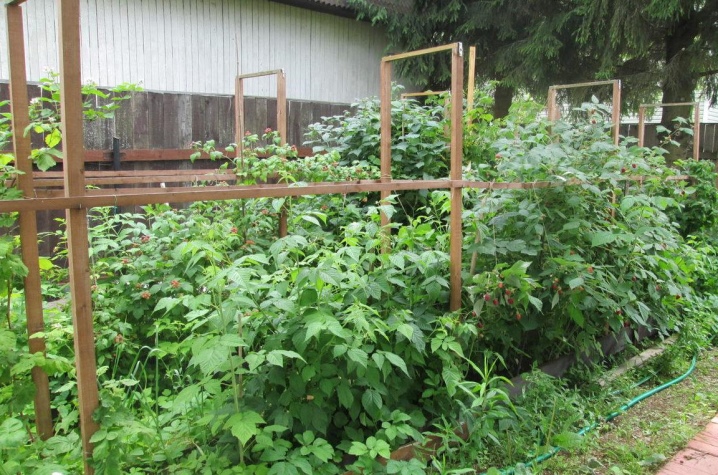
Description of species
Raspberry trellis differ in design. Supports allow you to support the bushes, are installed with a certain pitch. A beautiful support will also improve the appearance, decorate the space. For small shrubs, single-lane trellises can be installed, and for large shrubs, two-lane are better. The latter, by the way, also differ from each other and are selected based on the needs.
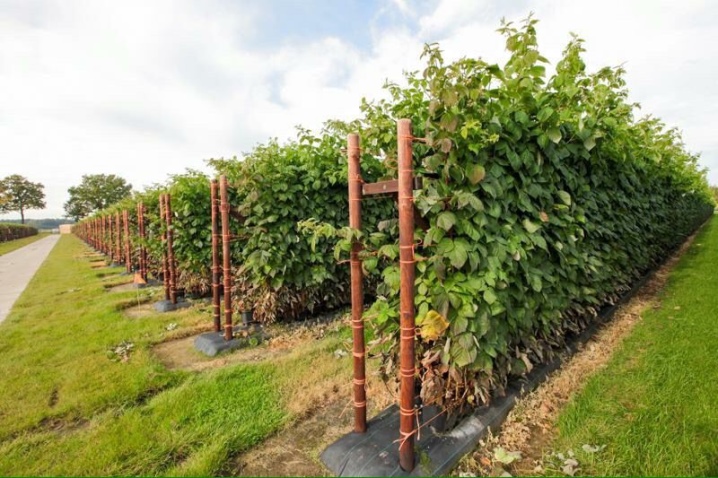
Single-lane
The supports are securely fixed in the ground, and a wire is stretched between them in several rows. Each raspberry stalk is tied to the twine. Tying can be loose, vertical, oblique, fan and horizontal. All species allow for the maintenance of raspberries during the growing season.
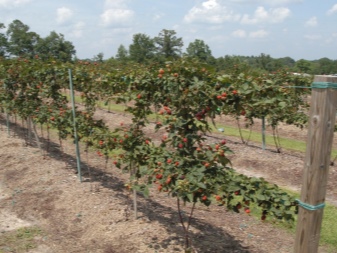
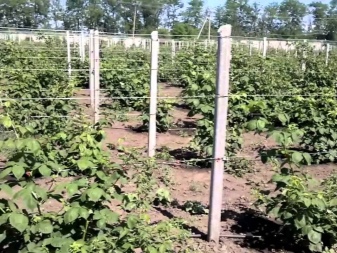
Such a trellis can also be used to prepare bushes for winter. The structure is installed in early spring, then last year's shoots are tilted and tied horizontally. As a result, the correct formation of the bush occurs. The shoots grow vertically, and the buds at the base remain dormant. Covering raspberries for the winter in this case will be much easier.
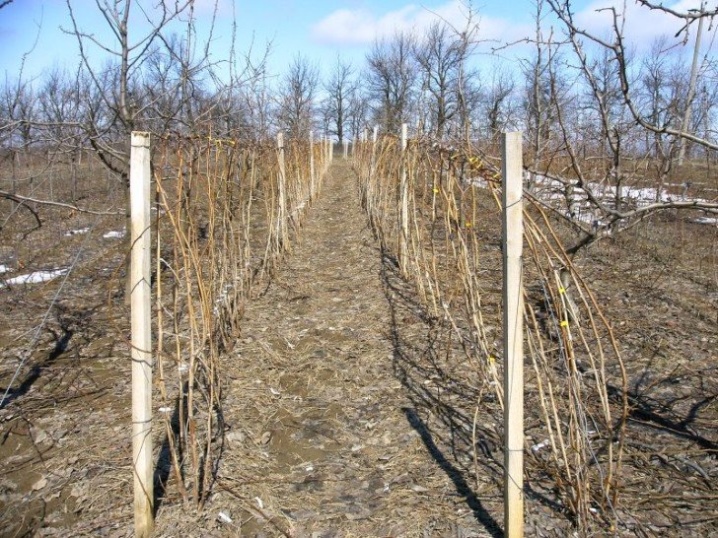
Single-strip tapestries have disadvantages. Each stem will have to be tied up and fastened separately, and this is a rather laborious process in the presence of a large number of bushes. However, in a small area, this does not create inconvenience. Such a trellis is well suited to owners of a small number of bushes.
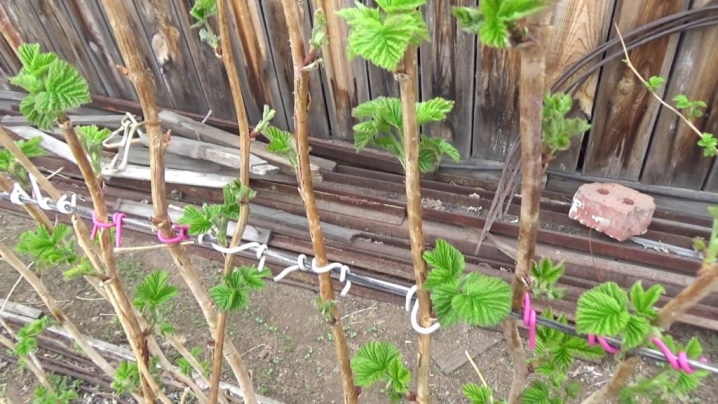
Two-way
Such designs are more serious and allow you to support a large amount of raspberries. The support is designed for heavy loads. At the same time, several design solutions are distinguished. Quite popular T-shaped trellises. They are made from wood, fittings, metal corners and pipes.
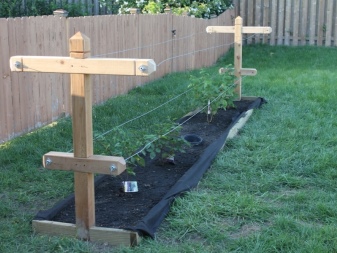
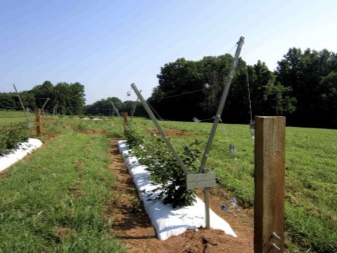
The cross bars are fixed to the main supports at an angle of 90 ° and the wire is tensioned at the edges. The stems are fixed on longitudinal rows, they must be directed in different directions. As a result, young raspberries receive the necessary amount of sunlight and heat. The design is simple, which attracts many gardeners.
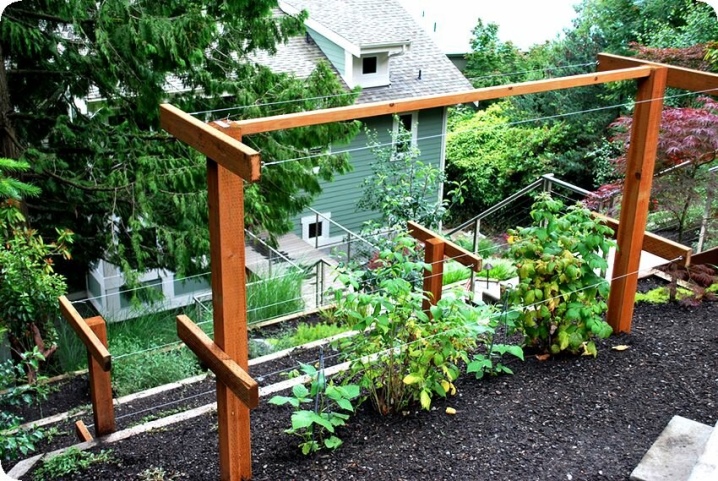
There is also a V-shaped trellis. There are two bearing planes in it, which are directed in different directions from the middle of the row. The structure itself is also sometimes called a two-lane inclined. Bushes are formed according to the same principle as in the case of the T-shaped pore. In this case, it is important to maintain a distance of 2 meters between the planes and the upper rows.

The best trellis for a raspberry tree is considered to be Y-shaped. The design is equipped with movable blades that are mounted on a swivel mount. This allows you to easily change the angle of inclination at any time, because the elements are raised and lowered. So even when the weather conditions change, it becomes possible to provide the bushes with the right amount of light.
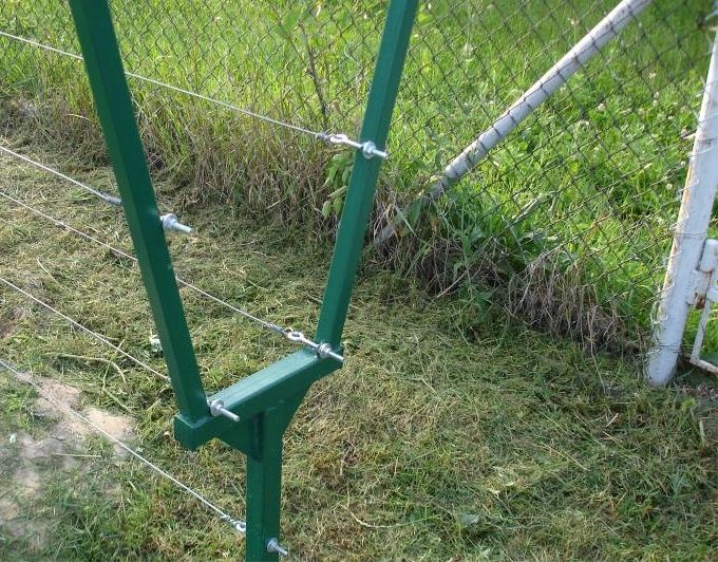
The horizontal tent structure is usually used on large farms. It is very bulky in itself. With its help, you can simplify harvesting and caring for bushes using special equipment. But in the country, such a support is not needed. There will be serious difficulties in mulching, pruning and fertilizing bushes.
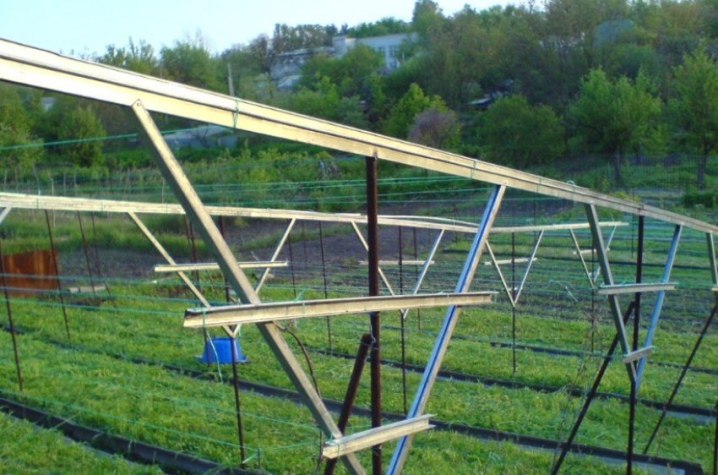
Dimensions (edit)
The type of construction is selected based on the characteristics of the raspberry tree. The simplest option involves 2 recessed bases and a tensioned wire in 2-4 rows with an interval of about 0.5 meters. For inclined tying, the support should be shifted 35 cm from the bushes. This will facilitate the development of young shoots.
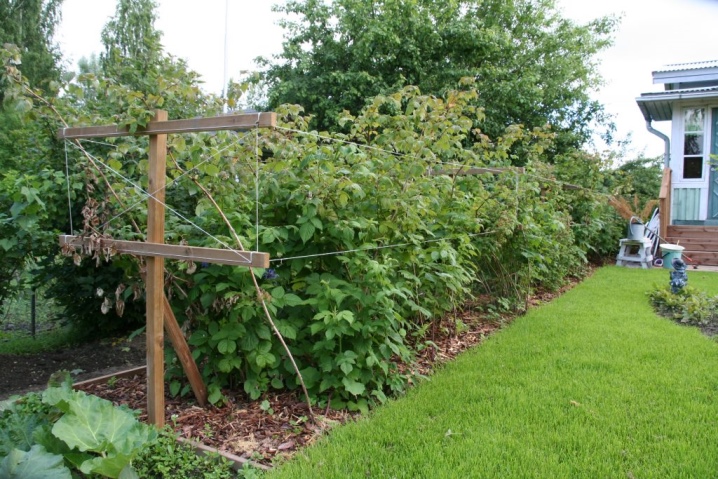
The width of the trellis usually varies between 0.6-3 meters. When choosing, one should take into account the thickness and height of the supports, the length of the raspberry rows, the tying method. The elasticity of the twine or wire tension is no less important. Typically, the height varies between 50-140 cm for medium-sized raspberries, 90-175 cm for tall varieties.
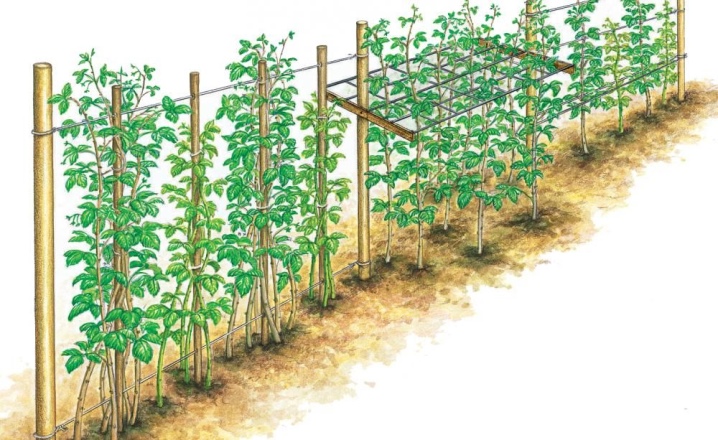
The total length of the posts is from 2.2 to 2.5 m. Supports should be 1.5-1.8 m above the ground. In this case, the part must be reliably deepened so that the structure does not fall, while breaking the bushes. It is optimal to leave a step of 10-20 meters between the posts. Thus, for 1 hectare of raspberries, 200-400 pieces are needed.
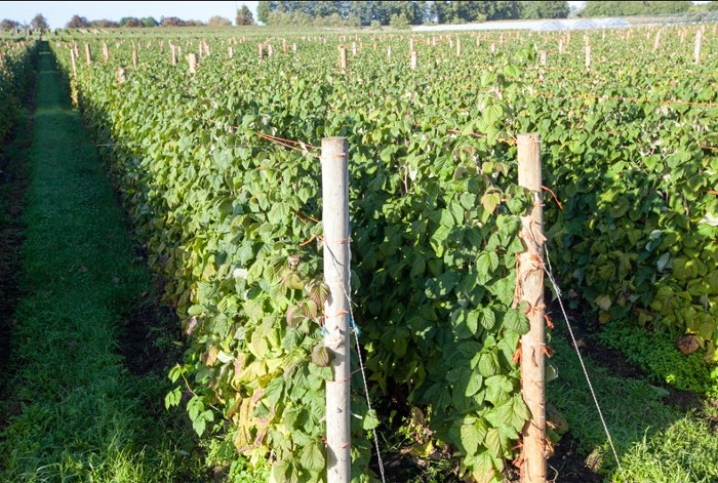
Materials (edit)
Raspberry bushes require additional support in the second year after planting. Therefore, during this time it is necessary to decide on the trellis and install it. Supports can be made of metal. Usually pipes or reinforced concrete poles are used. In the latter case, standard sizes 10x10 cm are suitable.
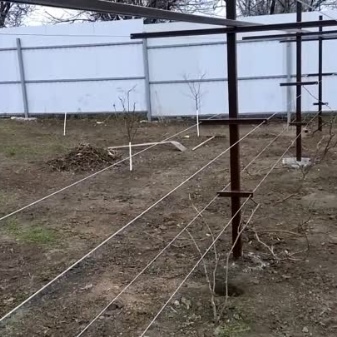
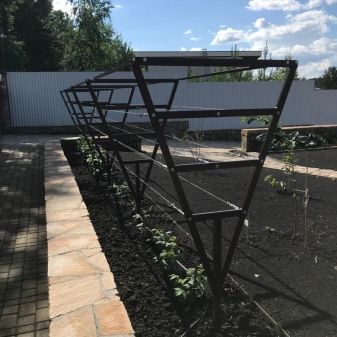
Alternatively, pipes with a diameter of about 8-10 cm are used. Such supports are durable and simple. Of course, the metal should be protected from rust, but this is not difficult at all. You can make a structure out of wood. It is easy to make it with your own hands without special skills.
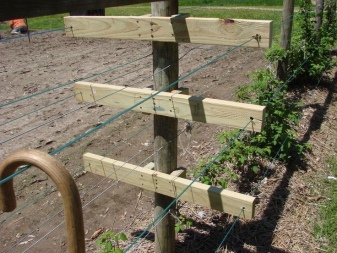
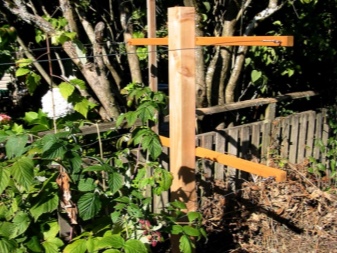
Metal poles are treated with special substances before installation. A popular anti-corrosion method is a bitumen bath. The tree also requires some preparation. Antiseptics prevent rotting and the development of parasites inside the support. You can simply withstand the pillars for 2-3 days in a solution of vitriol.
Simpler single-strip designs are often made from plastic pipes. Just keep in mind that the PVC structure is light and cannot withstand a serious load. Beams are often made from reinforcement. This alternative to pipes is more affordable and easier to work with.
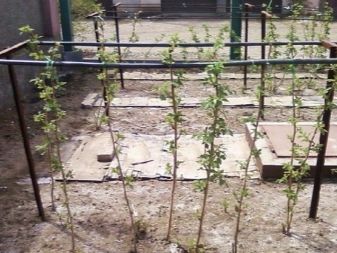
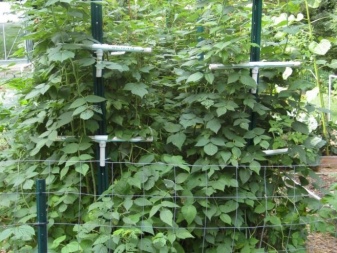
Stainless steel wire is suitable for tensioning vertical guides. Experts recommend using PVC-coated varieties, polyamide wire, reinforced twine with propylene or polyethylene. Such transverse structures will be safer and more reliable. If the base is made of wood, then usually the rest of the construction details are made of it.

The shoots are tied to the main wire using additional material. For the stems, use a long thread, soft wire or twine. You just need to braid the structural element along with the shoot. The ends are attached near the outer pillars.
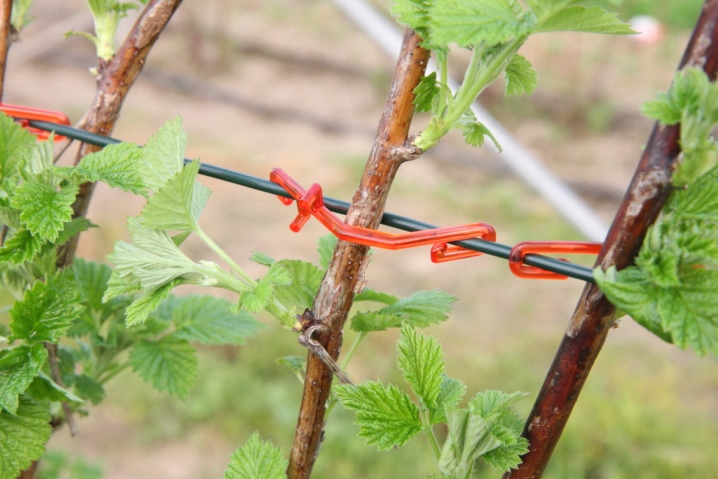
How to do it yourself?
Even a beginner can make a trellis - there is nothing complicated about it. You should first draw a diagram taking into account the type of structure. Drawings are especially important in the manufacture of trellises for a large raspberry tree. The most difficult thing is to deepen and fix the supports. It will be necessary to drive in stakes or prepare a grout to fill the pits.
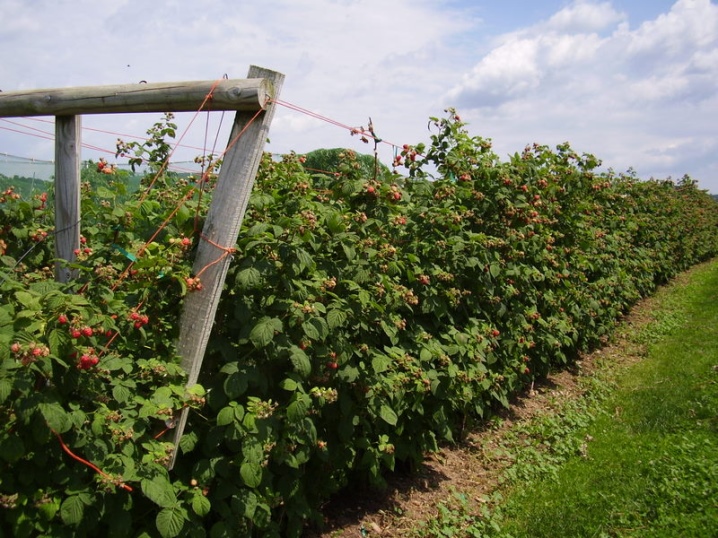
To make a T-shaped trellis from metal pipes, you need a power tool. You will definitely need a welding machine, an electric drill with drills, a grinder. And you should also prepare a hammer and tape measure. By the way, pipes can be not only new, but also used. The tapestry is made in several stages.

Here's a step-by-step guide.
-
Prepare support pipes and two crossbeams. The upper one should have a width of 60 cm, and the lower one - 50 cm. Between the beams there should be about 70 cm. Sometimes an intermediate beam is welded for reliability. In this case, a gap of 55 cm should be maintained from it to the ground.
-
Assemble the entire structure with a welding machine.
-
Smooth out any unevenness on the metal. Otherwise, there will be a high risk of injury on contact with the support. And also the stem can be damaged, which will adversely affect the health of the entire plant.
-
Drill small holes in all line or twine bars. The hole size is matched to the diameter of the sling.
-
Hammer both constructions at the beginning and at the end of the row of bushes. The upper exact one should be at the level of the tops of the raspberries. It is recommended to pre-dig holes twice the diameter of the pipe, install supports and concrete. Alternatively, a mixture of crushed stone and sand is used. At the same time, it is necessary to fill the pit gradually, ramming the material if necessary. So the trellis will be stronger and more durable than if you just drive it in.
-
Strengthen the bottom of the structure with a cross. The stop will avoid cases when the pipe simply turns around its axis. Small pipes can be used to make an anchor. You can also saw off a piece at an angle of 45 °. Weld one side of the support to the base of the trellis, and drive the other into the ground.
-
The last step is to pull on the lines. And you should do it as tightly as possible.
It is not much more difficult to make a V-shaped welded support for raspberries. For manufacturing, you will need the same pipes, jumpers and wire. From the tools, prepare a hammer, a welding machine, electrodes and a protective mask for work.
-
The jumpers should be flattened on the sides in advance.
-
Drill holes with a diameter of about 3 mm in each tube.
-
Drive the blanks into the ground. In this case, you should not drive in exactly, but at an angle. This is how the silhouette of the V-shaped trellis will emerge.
-
The bridges hold the entire structure and protect it from disintegration. They should be butt welded to the main pipes.
-
The last step will be to attach the support with a welding machine. It is also necessary to weld end-to-end. The support will not allow the trellis to fall when the wire is pulled.
-
If the row is more than 15 meters long, then three trellises are used. For the middle, in this case, you do not need to make support.
-
The last step is to pull the wire. This should be done as tight as possible so that it does not sag.
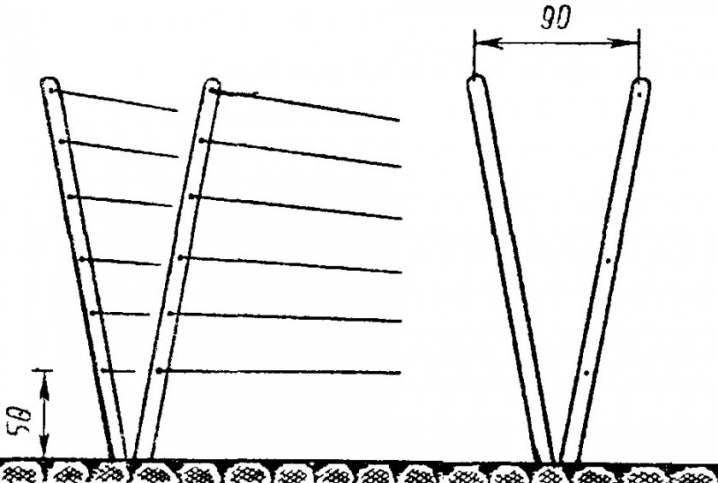
For the repair raspberry, it is more convenient to use a removable device. It is best to use a T-shaped trellis.Once harvested, it can be removed and stored until next season. In this case, raspberry stalks are simply mown for the cold season. The manufacturing process consists of several sequential steps.
-
Dig a hole 12 cm deep in the center of a row of bushes.
-
Install small pieces of metal pipes. This will prevent soil shattering.
-
Screw the cross-beams to two wooden posts of a suitable size. It is on them that the wire will then be pulled.
-
Install the assembled support into the prepared pit.
-
Tighten the wire or twine.
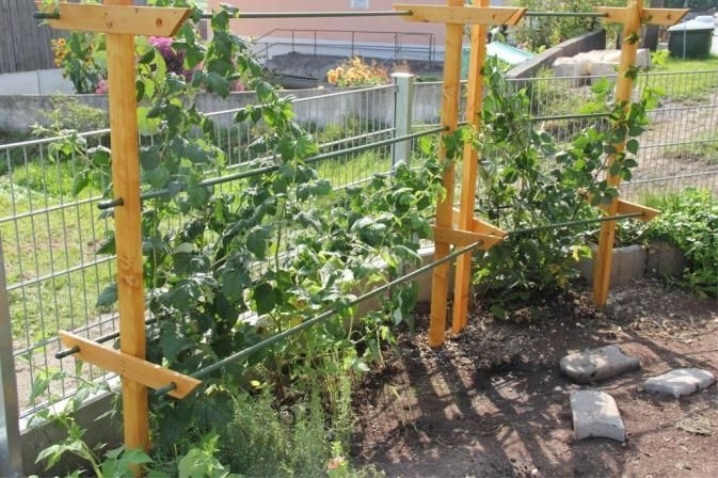
Raspberry garter
The method of growing bushes with trellis is considered the simplest and most convenient for gardeners. Such a solution in the country will save a lot of time while caring for the plant. The trellis makes it easier not only to fertilize the soil, but also to trim the bush itself.
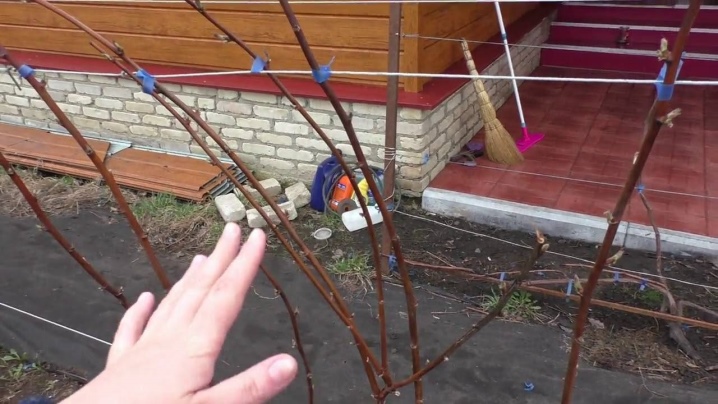
It is important to plant the raspberries correctly.
-
Dig a moat about 0.5 m wide or less.
-
Use a pitchfork to dig a trench.
-
Pour water over the ground. For 1 running meter, you will need about 10 liters.
-
Distribute the compound fertilizer evenly over the entire garden bed.
-
Place the seedlings at a distance of about 30 cm from each other. This simple solution will allow you to easily access each bush after the raspberry sprout.
-
Cover the roots of the planting material with earth. Pour everything on top and tamp.
-
Spread the rest of the soil evenly over the row.
-
Cut off the top of the planting material. There should be no more than 30 cm above the ground.
-
Round the root area with a large layer, at least 15 cm.
-
You should wait until the plant takes root and begins to germinate. Then you can proceed to installing the trellis.
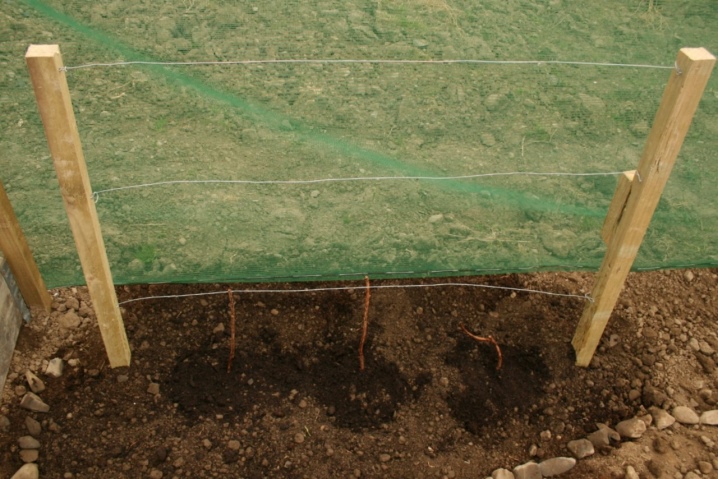
Every raspberry patch needs support. It allows not only to simplify care, but also to increase productivity. Usually the trellis is installed in the second year after planting. You should first prune the bushes. It is better to do this at the end of summer, after harvest. Trimming is done in a specific sequence.
-
Remove weak shoots and those that show signs of damage.
-
Remove all branches that have already borne fruit and have begun to grow stiff.
-
You can thin out the shoots. So, in the ideal case, there should be no more than 8 of them on the bush.
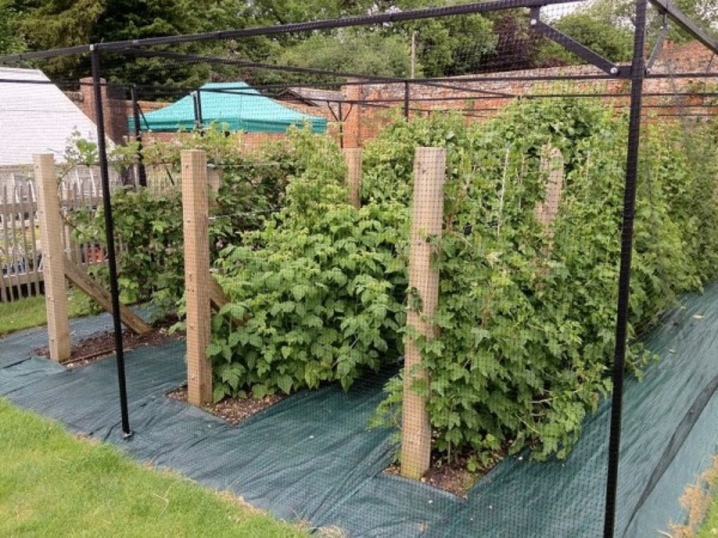
At the same time, it is worth removing all small growth, because it still will not survive the winter, but it will draw juices from the plant. In early spring, it will already be possible to tie raspberries to the trellis. Gardeners use different methods of attaching the plant to the supports.
They must be selected based on the needs and characteristics of the raspberry tree. Consider ways to tie raspberries to a trellis.
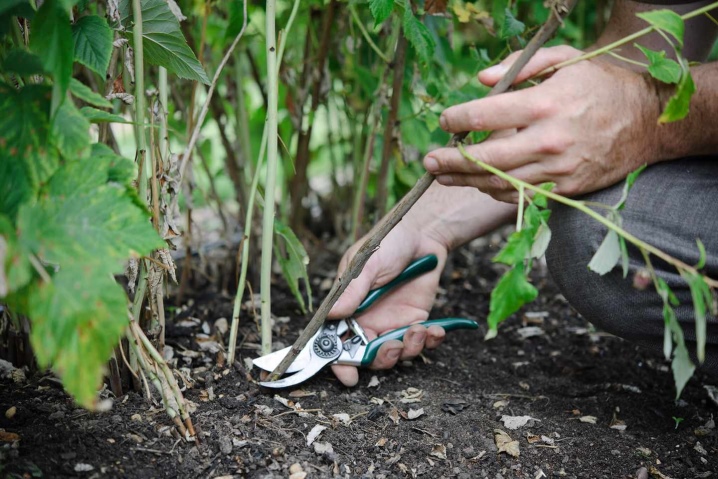
Consider ways to tie raspberries to a trellis.
-
Double. Used for two-lane trellis. Usually, the lower bar is located 1 m from the ground, and the upper one - 1.5 m. Shoots must be tied in two places and spread in different directions. About 50 cm is left between the stems. A double garter allows you to pay attention to each shoot. As a result, raspberries produce more yields. However, you will need to pick the berries carefully. The collection turns out to be laborious precisely because of the peculiarities of the location of the shoots.
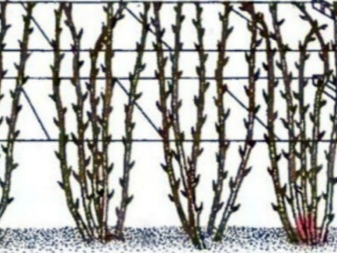
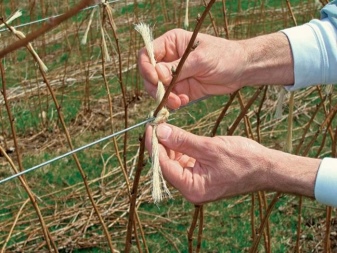
- Scandinavian method. The main difference is in the arrangement of the rows in relation to the ground. So, the lower bar should be raised by 1 m, and the upper one by 2 m. With this tying, no additional materials are needed. The shoot is not attached with anything, but simply wrapped around the wire to form a V-silhouette. The bush is well ventilated, which reduces the risk of various diseases. Harvesting is easy, the berries are in sight. And also with such a garter, raspberries grow well, because nothing interferes with the new growth.
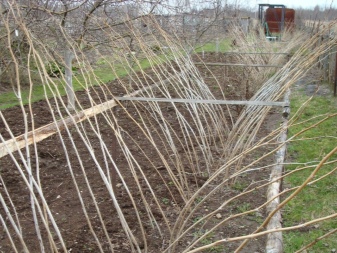
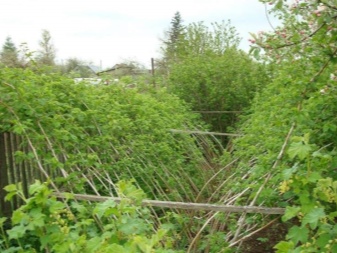
- Single way. It is used in tandem with a T-shaped trellis. Usually, the height of the supports reaches 2 meters or more, and the distance between them is 3-4 meters. Every shoot is tied up. In this case, it is important that the top of the bush rises above the trellis by no more than 20 cm. As a result, the shoots are not afraid of strong gusts of wind. However, the risk of damage to young stems is too great.
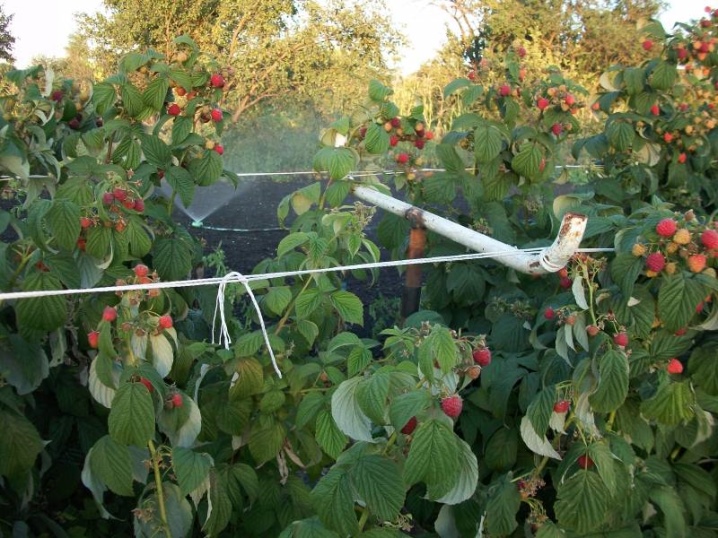
- Movable turnstile. If a Y-shaped trellis is installed, then this method of tying is optimal. Shoots are attached to the supports, if necessary, the angle of inclination changes. As a result, it is very easy to harvest. You can change the location of the shoots depending on the stage of development of the raspberry. Taking care of the bushes is very simple, as well as fertilizing.
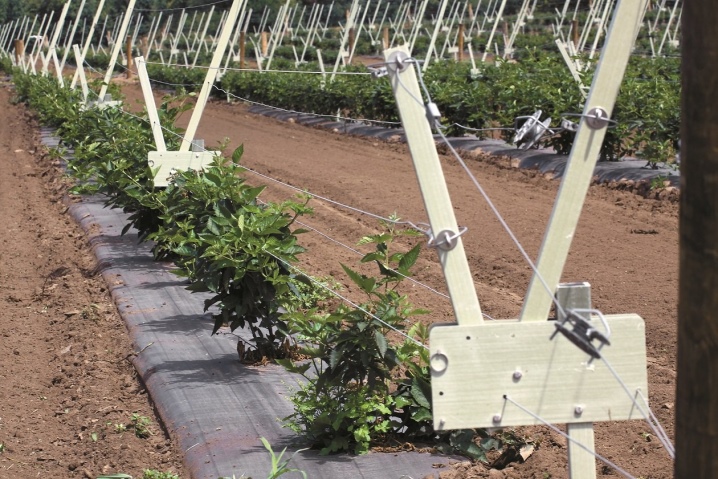
- Fan way. Pillars are placed between the raspberry bushes. The plant is divided into two parts, each is attached to different slats. As a result, half of the bush is tied to the right support, and the second to the left. A good solution if you are growing a lot of raspberries. More common on farms.
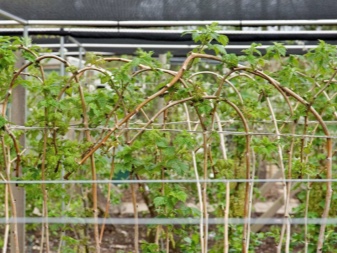
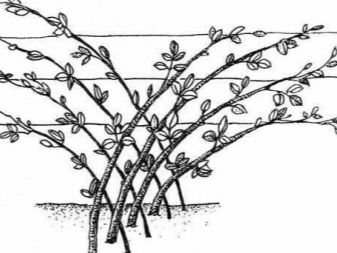
Types of raspberry trellis in the video below.













The comment was sent successfully.